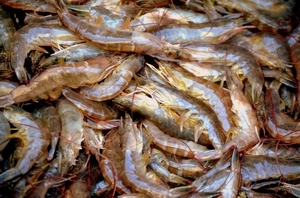 d shrimp prices due to the early mortality syndrome (EMS) outbreak has impacted retailers and foodservice buyers all over the globe. In the U.S., while supermarkets and restaurant owners are reluctant to raise prices, some have been forced to, SeafoodSource reports.
d shrimp prices due to the early mortality syndrome (EMS) outbreak has impacted retailers and foodservice buyers all over the globe. In the U.S., while supermarkets and restaurant owners are reluctant to raise prices, some have been forced to, SeafoodSource reports.“Some restaurants are going to smaller sizes of shrimp or maybe changing the species of shrimp, to try to still offer it on the menu. I would rather stick with shrimp that is great and have to charge a little more for it. The vast majority of our guests will pay more for the highest quality product,” Ralph Rubio, co-founder of the 200-unit fast casual seafood chain Rubio’s in San Diego, Calif..
Rubio’s wants to stick with Pacific White 41/50s shrimp, which it introduced in entrees around two years ago. “It is very foundational to what we are trying to do with the menu. We do a warm shrimp salad, we just introduced our Salsa Verde Shrimp Tacos, and we designed a new shrimp and bacon burrito. We are really going down the shrimp road, and then these high prices come along,” Rubio said.
However, Rubio’s has found that the size and quality of the Pacific shrimp works best for its entrees. As a result, the chain had a “small price increase” on shrimp entrees starting in October. “As we go into February, we might take a percentage or two [increase], but that is across the entire menu, not just shrimp entrees. Commodity prices are going up on not just shrimp, but some of our other commodities,” Rubio said.
Seafood retailers — both large and small — are also facing higher prices on farmed and wild shrimp. “The farm-raised issues are driving prices across the board. There is not as much disparity between the wild and domestic price,” said Brian Aiello, general manager of Robert’s Seafood Market in Springfield, Ill.
Around 60 percent of Robert’s Seafood Market’s shrimp selection is domestic, wild product, compared to around 40 percent that is farm-raised.
“We were reluctant to creep up on prices, but we had a small price increase that I would estimate at 10 percent,” Aiello said. While other retailers have switched to carrying smaller sizes of shrimp, Robert’s is sticking with 26/30s for farmed shrimp. “We have not gone to a smaller shrimp. Hopefully, we will weather this Christmas season. We are trying to protect the dollars first of all,” Aiello said.
Instead, Robert’s is focusing more on promoting lobster and crab for the holidays. “There is better lobster pricing right now, so we are going a little more aggressive on getting that exposed. We will do more volume on lobster and crab, and shift any potential loss on shrimp,” Aiello said.







